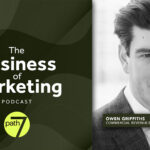By Jordan Harper, Executive Strategy Director, Iris
After a three-year hiatus, 2022 saw the welcome return of one of my favorite ways of kick-starting my brain for the year ahead: the SXSW Interactive festival in Austin, TX. Although last year’s online-only experiment was a valiant effort at delivering inspiring content, as anyone who’s been will quickly tell you, SXSW is about much more than just sitting back and working-through a program of talks.
One of Those Things – That I Got an Early Reminder of This Year – Is the Power of Serendipity.
Let me explain.
In the first time slot on the first day of the festival I had bookmarked “How to Have More Fun (and Why You Should)” with author Catherine Price, who was all set to give me a fresh perspective on work/life balance, define “True Fun” (as opposed to “Fake Fun”) and set me on a path to being happier, healthier and more alive! All good things of course, and all things any strategist, marketer or creative who’s spent the last two years grinding will tell you they need more of.
But it was not to be. The session was full. No room at the True Fun Inn.
In a familiar panic, I hurried over to the biggest venue at the festival – which also happened to be the closest to me – where I sat down just as Priya Parker began her talk “On Gatherings.”
This was clearly where I was meant to be: in a big gathering at the first big gathering I’d been able to be part of in two years, talking about gathering. The power of serendipity!
Parker discussed what felt like the central meta-topic of SXSW 2022 – and which almost every subsequent speaker mentioned at the beginning of every talk: isn’t it great to be here in person again?
It’s not that we’ve not been gathering over the last year, we’ve just been doing it differently. Zoom Birthday parties, Facetime calls with (geographically) distant relatives, Saturday night hangouts with old school friends, remote learning, and of course… meetings. So many meetings.
In many ways, those gatherings have been harder. Rather than an easy silence amongst friends, or the ability to just sit and listen, there’s been a more active pressure on us to interact and consciously decide to be “in”’ the meeting. But friction in gatherings can be a positive thing too, such that we’ve been forced to question why we’re there and how meaningful they are rather than just turning up at a party, making smalltalk and then going home.
It’s no coincidence that among the many things that have accelerated in the last couple of years is the polarization of people’s views online. Discussing and debating complex and challenging topics benefits hugely from gathering in-person, where body language and almost imperceptible nuances in our voices and facial expressions do a much better job at conveying our understanding (or lack thereof), as well as subtlety and complexity.
With much talk across the business world concerning when people will return to the office, Parker implored us to ask the more important question of why.
Which moments over the last two years have made you long to be in the same room as the person you’re talking to? What things about an office or workplace have you missed and what things do you pray never come back? Did you invent any new rituals or techniques while we’ve been apart? What new things might we invent as we take our steps back into communal spaces, gathering IRL regularly for the first time in two years?
Asking these questions of yourself and your teams is one of the most important topics in business right now. For decades, the answer to “why do we go to the office” was simple: to work. That answer no longer carries any meaningful weight. We can all work from home perfectly adequately, in some cases and in some ways much better than we ever managed to work from an office.
So why do we go to the office?
To gather. To be surprised. To find serendipity – like a conversation you didn’t intend to hear, but that ended up being exactly what you needed to hear.
And Then There’s the Power of Resilience.
After a triumph of serendipity came a triumph of planning, which is to say that I attended a talk I intended to attend, and one that is a favorite of mine every year at SXSW: The annual report from legendary designer, technologist and author John Maeda.
What began as the “’Design in Tech” report some seven years ago, morphed into the “Computational Experience” report in 2020, but this year Maeda had a fresh view on what he’s learned in the last 12 months that he’s calling the “Resilience Tech Report.”
Maeda argued that chasing efficiency has made the world – and many businesses – brittle. When you focus on trimming away all the fat, you risk losing the ability to react to change, you break rather than bend as the world accelerates in directions we’re not always great at predicting. Success is now dependent on our ability to be resilient to change: not just staying on two feet when the ground moves beneath you, but finding yourself stronger when it settles.
Global supply chains are great for efficiency, cheap labor thousands of miles away is certainly a way to shave down manufacturing costs, but you have no control over the change in that place, and no way to quickly react when things change there. Volume deals mean cheaper costs, but they also mean over-reliance on single suppliers.
One of Maeda’s theories is that to be resilient is to resist the primal urge of ‘flight’ when faced with the unexpected and the dangerous, and it’s stayed with me. The simplest way to be resilient is to find the courage and creativity in the face of change to build the next iteration of your world, to keep moving, resist the urge to dig-in and wait for the storm to blow over. To fight.
Just like Priya Parker’s advice to be more mindful about how we gather, the same goes for how we fight in the face of change. It’s not about resistance, but resilience – using change to propel ourselves forward and fight not to try and reverse it or return to ‘before’, instead fighting for a position at the front of the queue when the change slows down.
As strategists, it’s our job to help businesses make those bold calls to push into the unknown, to help our clients resist the urge to protect their positions rather than embrace change and move forwards. There’s a tendency to feel like we’re ‘through the worst of it’, that we now need to acclimate to where we are, but I don’t believe that’s the case at all.
A global pandemic – the Great Accelerator – has kicked off a period of exponential change that’s only just begun. Now is the time to be bold, step forward and fight to be a part of the world that is still being re-built.






